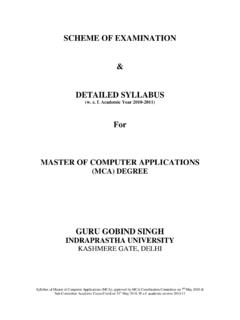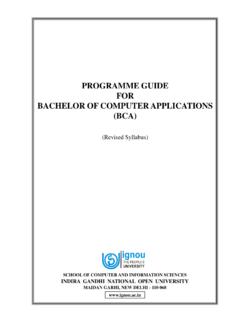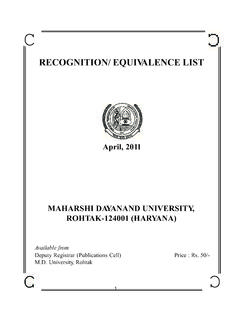Transcription of University Of Pune
1 Page no:1 University Of pune syllabus for master Of computer Applications ( ) MCA (Part I ) From Academic year 2008-2009 MCA (Part II ) From Academic year 2009-2010 MCA (Part III ) From Academic year 2010-2011 ( I ) Introduction: 1. The name of the programme shall be master Of computer Application ( ) Integrated. 2. The knowledge and skills required planning; designing and build Complex Application Software Systems are highly valued in all industry sectors including business, health, education and the arts. The basic objective of the education of the Masters programme in computer Application ( ) is to provide to the country a steady stream of the necessary knowledge, skills and foundation for acquiring a wide range of rewarding careers into the rapidly expanding world of the Information Technology.
2 3. The Job Opportunities are: 1. Many graduates begin their career as a junior programmer and, after some experience, are promoted as system analysts. Other seek entrepreneurial role in the computer world as independent business owners, software authors, consultants, or suppliers of systems and equipments. Career opportunities exist in such areas as management software and hardware sales, technical writing, training others on computer , consulting, software development and technical support. 2. Application areas include transaction processing (such as order processing, airline reservations, banking system), accounting functions, sales analysis, games, forecasting and simulation, database management, decision support and data communications.
3 4. Specific elective courses to be offered in functional areas have to depend on student preferences, faculty availability and needs of the user systems in the region in which the educational institution is located 5. The program is a mix of computer -related and general business courses. The computer related courses use microcomputers to introduce standard techniques of programming; the use of software packages including word processors, spreadsheets and databases; system analysis and design Tools. The general business courses include the functional areas of management like accounting, sales, purchase, inventory, and production. The course would emphasis the study and creation of business applications, rather than more programming. This would emphasize on domain knowledge Page no:2 of various areas, which would help the students to build software applications on it.
4 The students are exposed to system development in the information-processing environment, with special emphasis on Management Information Systems and Software Engineering for small and medium computer systems. Also, exposure to microcomputer technology, micro-based systems design and micro applications software, including network and graphical user interface systems is provided. 6. The Integrated programme will be a full-time three years master s Degree Course of computer Applications. 7. The new Curricula would focus on learning aspect from three dimensions viz. Conceptual Learning, Skills Learning and Practical / Hands on. 8. The inclusion of projects at three levels ensures the focus on applying the skill learnt at respective levels. 9. The Institutes should organize placement programme for the students, by interacting with the industries and software consultancy houses in and around the region in which the educational Institution is located.
5 10. Ordinarily, in each class, not more than 60 students will be admitted. (II) (A) Eligibility for Admission: The eligibility criteria for admission for the MCA course will be as decided by the Competent Authority (Director, Technical Education-Government of Maharashtra, &/or AICTE, New Delhi) 1. A candidate who has either passed with minimum 45% of marks in the aggregate (40% in case of candidate who is domiciled in Maharashtra and belongs to the reserved categories , , , , , ) or appeared at the final year examination of a post 10+2 course of minimum three years duration leading to an award of Bachelor s Degree, in any discipline by the Association of Indian Universities or has passed with minimum 45% of marks in the aggregate (45% in case of candidate who is domiciled in Maharashtra and belongs to the reserved categories) or appeared at an examination considered equivalent there to would be treated as eligible for Common Entrance Test(CET).
6 Also the candidate must have passed mathematics/Business Mathematics & Statistics paper for 10+2 or graduation Level and Passed the CET conducted by Director of Technical Education MS with non-zero score for that year OR Passed the CET conducted by State level MCA Association with non-zero score for that year , Or Passed the AIMCET exam for that year . 2. However, a candidate would not be treated as eligible for admission to the MCA programme unless he/she passes his/her qualifying examination with Page no:3 requisite percentage on or before 30th September of the concerned academic year and also passes in the CET. Generally, candidate passing all the papers that are generally covered over a period of minimum three years in one sitting are not considered eligible.
7 Likewise, candidates possessing the qualifying degree although with requisite percentage of marks, whose duration is less than three years, are not considered eligible. (B) Reservation of Seat: The percentage of seat reserved for candidates belonging to backward classes only from Maharashtra State in all the Government Aided, Un-aided Institutions/Colleges and University Departments is as given below: A) Scheduled caste and Scheduled caste convert to Buddhism B) Scheduled Tribes including those living outside specified areas C) Vimukta Jain (14 as specified) D) Nomadic Tribes (NT1)(28 before 1990 as specified) E) Nomadic Tribes (NT2)(Dhangar as specified) F) Nomadic Tribes (NT3)(Vanjari as specified) G) Other Backward Class Total 1.
8 Candidate claiming to belong to categories mentioned against (e),(f) and (g) above will have to furnish certificate from appropriate authority that the candidate s parents do not belong to Creamy Layer as per the relevant orders of the Government. 2. If any of the (a) to (g) categories mentioned above does not get the required number of candidates for the percentage laid down in a University area, the seats so remaining vacant shall be filled in from among the candidates of remaining reserved categories with reference to the inter-se-merit of all candidates belonging to the reserved categories from the same University area. However, the total reservation shall not exceed 50%. After doing so the seats remaining vacant shall be filled in with reference to inter-se-merit of all the candidates from the same University area.
9 (C) Selection Basis: The selection would be done as per the guidelines given by the Director of Technical Education Maharashtra State time to time. (III) Number of Lectures and Practical: Lectures and Practical should be conducted as per the scheme of lectures and practical indicated in the course structure. (IV) Practical Training and Project Work: At the end of the sixth semester of study, a student will be examined in the course Project Work . Page no:4 1. Project work may be done individually or in groups in case of bigger projects. However if project is done in groups, each student must be given a responsibility for a distinct module and care should be taken to see the progress of individual modules is independent of others. 2. Students should take guidance from an internal guide and prepare a Project Report on Project Work in 2 copies to be submitted to the Director of the Institute by 30th April.
10 Whenever possible, a separate file containing source-code listings should also be submitted. Every student should also submit at least 4 typed copies of their project synopsis. Their respective Institutes should forward one copy of this synopsis to each of the external panel members, in advance of the project viva dates. 3. The Project Synopsis should contain an Introduction to Project, which should clearly explain the project scope in detail. Also, Data Dictionary, DFDs, ERDs, File designs and a list of output reports should be included. 4. The project Work should be of such a nature that it could prove useful or be relevant from the commercial/management angle. 5. The project report will be duly accessed by the internal guide of the subject and marks will be communicated by the Director to the University along with the marks of the internal credit for theory and practical to be communicated for all other courses.
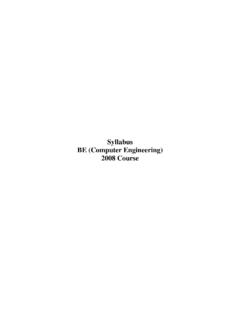
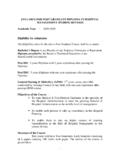
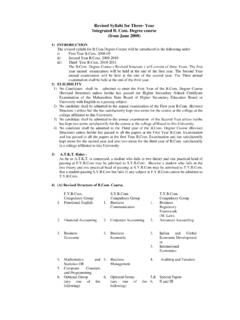
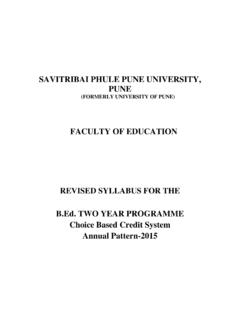
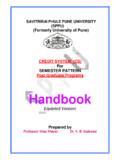
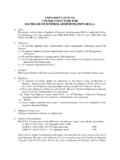
![[4372]-101 - Savitribai Phule Pune University](/cache/preview/f/c/3/4/c/a/0/f/thumb-fc34ca0f7a382c46206f2b1007598e60.jpg)

